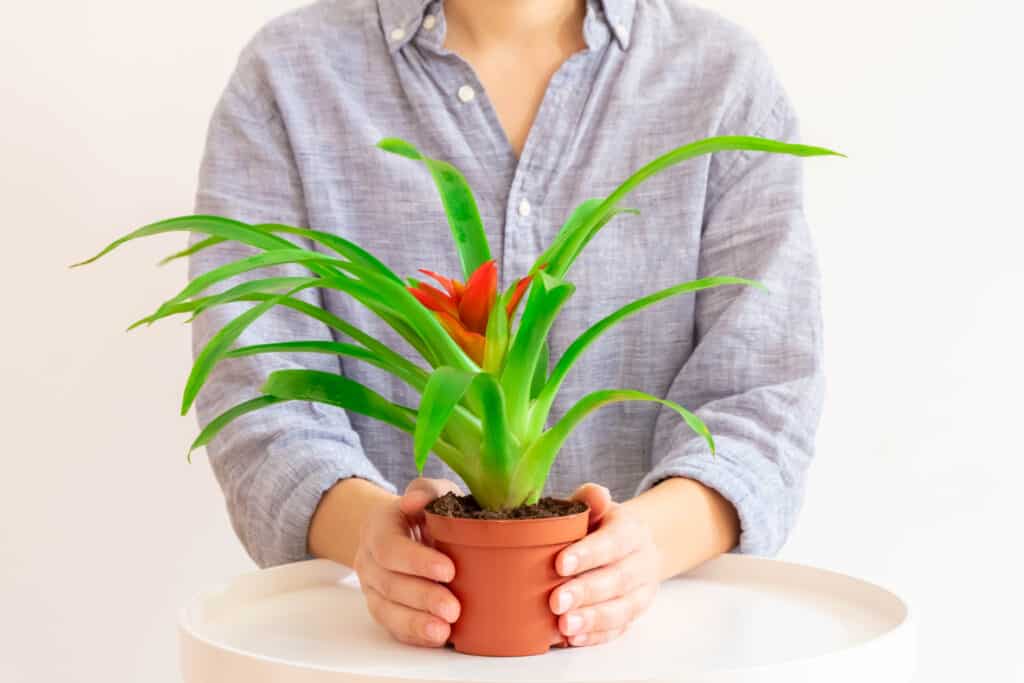Bromeliads are flowering plants that are native to places with tropical or subtropical climates. Among the most common types of bromeliads are guzmania, aechmea, neoregelia, vriesea, and pineapple.
People usually get a bromeliad plant to serve as a decorative element in their home. As the plant blooms, growers eventually have to learn how to transplant bromeliad offshoots into a new pot.
Why Should You Transplant Bromeliads?
Almost all bromeliad plants bloom only once. When the plant matures, its beautiful flower will come into full bloom, but it will also cease to produce any more leaves. Sad as it may sound, this signifies that it’s about to die in the next few months.
Fortunately, before the bromeliad dies, it also produces pups or offshoot plants that are genetic clones of the mother plant. This is the bromeliad’s way of handing down its genetic legacy and propagating its genes to the next generation.
Hence, even if the original plant dies off eventually, you’ll still be able to continue growing and enjoying the beauty of your plants. You just have to make sure that you transplant them properly when the time comes.
Caring for bromeliad pups is a great way to start your plant collecting endeavor and prettify your garden. On the other hand, you can also give them away to friends who are interested in growing them too.
How to Know When It’s Time to Transplant
A single bromeliad plant typically yields many pups. Thus, even if you only buy one or a few, you’ll always end up with more pups to care for than when you first started.
It’s generally recommended to cut the pup from its parent plant when it reaches one-third or two-thirds of the mother plant’s size. It’s worth noting that leaving pups attached to the mother plant for a longer time means that they’ll mature faster. This is because they’re able to get more nutrients while they’re developing, thereby speeding up their growth process.
Meanwhile, removing the pup sooner can be the way to go if you wish to have more bromeliads in the future. In this case, the mother will be able to produce more pups in its lifetime. Ultimately, your priorities will dictate how soon you’ll transplant your bromeliad pups.
Supplies Needed
To ensure that the transplant process will go smoothly, you’ll need the following tools:
- Plant pot
- Box
- Potting soil
- Fertilizer
- Shovel
- Secateurs or sharp knife
- Support (sticks, stakes, chopsticks, or pencils)
- Garden gloves
Steps to Transplant
As mentioned earlier, you may start detaching the pups when they’ve reached one-third or two-thirds of the mother plant’s size. Some of these pups will not have any root system or developed roots, to begin with, but they’ll soon grow their root when the transplant is complete.
Here’s a step-by-step guide on how to properly transplant your pups:
- With garden gloves on your hands, firmly hold the original plant with one hand, and the pup that you’re planning to detach with the other. Try to break it off from the mother stem by pulling it away and then downwards.
- If the pup doesn’t budge, use your secateurs or knife to cut the pup from the original plant. There are instances when an outer leaf will be protecting the pup’s base. Gently peel this protective leaf to see the whole base.
- Plant your pup in a plant pot that contains approximately 3 inches of well-draining potting medium.
- Since pups’ roots aren’t developed yet, the top part of the plant may be too heavy to keep it stable. This is where you’ll need to apply your support materials so the plant stays upright while it grows roots.
- Replace the soil around the original plant and feed it with fertilizer that’s half the usual ration. This will encourage the production of viable pups until the plant dies.
- Place the newly transplanted plant where there’s indirect sunlight.
- The potting medium must be kept moist but not regularly wet. Hence, water it on top of the plant, and not around the soil.
During the transplant, pups are at a critical stage of their development. Excess water may lead to rotting at the plant’s base, which reduces the chances of survival.
The Pups Are the Mother Plant’s Legacy
When the pup is rooted enough, you can then remove its support and place it where there’s a little more sunlight. Always remember the three most important things that growing bromeliads need: warmth, humidity, and light.
Bromeliads may only bloom once in their lives, but they make sure that their legacy doesn’t end with them. Your original plant will produce offshoots that can make your garden as pretty as before. However, you have to ensure that you transplant them properly so the bromeliad legacy lives on.
Taking care of bromeliads can be a remarkable experience for the avid gardener. The growth process of bromeliads is typically around 2 to 3 years — a cycle that you can easily rinse and repeat once you’ve had enough practice.

